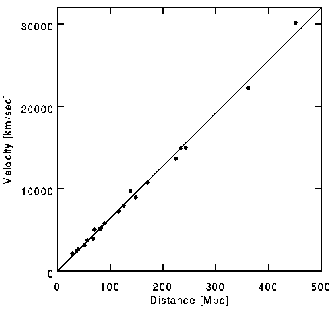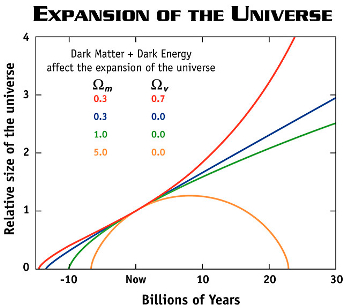6th Week: The Early Universe and Big Bang Nucleosynthesis B
Thermal History of the Big Bang
The cosmological principle
This principle states the following:
When averaged over a large enough volume, the universe appears the same in all locations.
Here large enough means larger than 500 Mpc (recall that 1 pc or parsec is equal to km).
Consequences of the cosmological principle:
- The universe has no boundaries.
- The structure of the universe is not so special that the laws of physics are inapplicable.
Hubble expansion

In 1929 Edwin Hubble discovered after years of observations, that galaxies were moving away from the Earth at a velocity proportional to the distance from those galaxies to the Earth. This is
where is the Hubble constant. His original calculation of the constant yielded a value of about 50 (km/s)/Mpc. The current accepted value of this constant is (km/s)/Mpc.
Friedman equation
If one consider the Universe as an isotropic and uniform gas, the expansion in time of this gas is given by
which is called the Friedman equation. Here is the proper energy density of the universe, G is the gravitational constant, c is the speed of light, and k is the curvature parameter. We also have to consider the energy-momentum conservation law which can be expressed as
where is the pressure. The so-called scale factor , comes from the assumption that the metric of the universe is given by
where is the three dimensional metric.
In order to solve Friedman equation one should have as a function of so that we find with equation (2) the energy density in terms of . Using this result we could find from equation (1) a time dependent solution .
Solution to the Friedman equation

Depending on the curvature parameter we can have three physically different solutions to the Friedman equation:
- Whit k<0 the Universe is expanding with a positive acceleration and will expand forever. There is not enough density to attract back all the matter in the Universe. The end result of this case is called Big Chill.
- With k=0 we get a flat Universe. The density of the Universe is at its critical value so there is an equilibrium between the gravitational attraction and the repulsion due to the Big Bang. The Universe will continue expanding forever.
- The case k>0 represents a closed Universe. The density is high enough so that the gravitational force will attract all matter back to a single point. This is referred as Big Crunch.
Time evolution of temperature
The universe is expanding. Basic thermodynamical laws state that the universe cools as it expands. This is exemplified in the cosmic microwave background (CMB). The CMB today has a temperature of about 2.7K, but is highly red-shifted. Correcting for the red-shift one finds that the original temperature of this radiation peaked at about 3000K. As stated before this correlates with the combination of protons and electrons into hydrogen. Though this shows that the universe cools as it expands, the universe would need to be even hotter to produce all of the particles one sees today. Here is a temperature evolution table based on the major cosmological events of the big bang:
- Time: 1E-12 s, Temperature: 1E15 K, Event: Primordial Soup of fundamental particles
- Time: 1E-6 s, Temperature: 1E13 K, Event: Protons and Neutrons form
- Time: 3 min, Temperature: 1E10 K, Event: Nucleosynthesis begins
- Time: 3E5 yrs, Temperature: 3000 K, Event: Atoms Form
- Time: 1E9 yrs, Temperature: 10 K, Event: Galaxies Form
- Time: 1E10 yrs, Temperature: 3 K, Event: Today
Also, it is theorized that at one point all of the fundamental forces were once unified. To do this large amounts of thermal energy (kT) is needed. The separation of the forces occurred approximately as follows:
- Time: 1E-43 s Energy: 1E19 GeV Separated Force: Gravity
- Time: 1E-35 s Energy: 1E13 GeV Separated Force: Strong
- Time: 1E-12 s Energy: 2 GeV Separated Force: Weak
Cosmic microwave background
Discovered (accidentally) in 1965, the CMB is a nearly perfect blackbody radiation spectrum visible in all directions at a temperature of ~2.75K. It marks the point in the history of the Universe at which recombination removed free electrons and thus decoupled the radiation field from the surrounding matter. This would've occurred at about 3,000K, or 4,000 years after the Big Bang. After this point, photons continued without interaction, becoming red shifted with the cosmic expansion from their original temperature of 3,000K to the current CMB temperature.
The high homogeneity of the CMB poses a problem for the Big Bang Theory, as it suggests distant parts of the universe must've been in thermal contact in order to reach equilibrium, while the scales involved in a steady expansion would mean that their light cones could not have intersected before recombination. The solution generally accepted to this problem is that recombination was preceded by period of 'inflation', accelerated expansion, allowing material to be close enough for thermal contact in the early universe.
Despite being almost isotropic (once effects of the Earth's motion relative to the Cosmic center of mass are subtracted off), different regions of the CMB do differ a few microKelvin. These inhomogeneities are measured in terms of the order of the multipole expansion needed to create them (a smaller order corresponding to a larger angular 'object' on the sky), and are thought to be due to acoustical fluctuations in the primordial plasma creating velocity, density and thermal inhomogeneities.
Nucleosynthesis of the Big Bang
The Big Bang Nucleosynthesis yielded mostly Hydrogen, and Helium with trace amounts of Lithium and Beryllium (as almost all of the neutrons went into helium formation).
The reactions yielding these isotopes were:






















